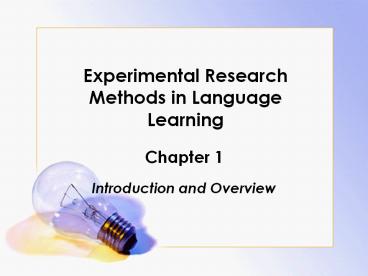Experimental Research Methods in Language Learning - PowerPoint PPT Presentation
Title:
Experimental Research Methods in Language Learning
Description:
Experimental Research Methods in Language Learning Chapter 1 Introduction and Overview Leading Questions What is research? What do you think experimental researchers ... – PowerPoint PPT presentation
Number of Views:276
Avg rating:3.0/5.0
Title: Experimental Research Methods in Language Learning
1
Experimental Research Methods in Language Learning
- Chapter 1
- Introduction and Overview
2
Leading Questions
- What is research?
- What do you think experimental researchers do in
their research? - Do you think whether an experimental research
design can provide an insight into language
learning? Why or why not?
3
Experimental Research in Language Learning
- A systematic, quantitative research design that
aims to - understand aspects involved in language learning,
particularly those that influence language
learning or use. - examine a causal-like relationship between
variables in language learning or use - evaluation the condition in which language
learning can be optimized.
4
Examples of Experimental Studies
- Chen and Truscott (2010) examined the effects of
repetition and first language (L1) lexicalization
on incidental vocabulary learning using a
posttest and delayed posttest experimental
design. - Ammar and Spada (2006) investigated the effects
of two corrective feedback techniques (recast and
prompts) on students language learning
performance.
5
Academic Research
- An intellectual act to discover new facts or
knowledge by attempting to go beyond existing
knowledge through observing, collecting, and
analysing evidence. - Academic research requires planned and organized
actions for collecting and analyzing data in
order to make appropriate inferences and
warranted conclusions about the topic or problem
under examination
6
Primary versus Secondary Research
- Primary research concerns first-hand data
(referred to as empirical data) from research
participants or documents to answer research
questions. - Secondary research does not require researchers
to collect new empirical data (e.g. library
research and a review of the research
literature).
7
Applied Linguistics and Language Learning Research
- Applied linguistics is an interdisciplinary field
of research inquiry that is mainly concerned with
language use in social contexts. - Key areas of applied linguistics closely related
to language education include language
acquisition, learning and pedagogy, language
testing and assessment, and bilingualism and
multilingualism.
8
Aims of Language Learning Research
- To explore individual and environmental aspects
associated with language learning or use - To describe characteristics of language learning
phenomena - To explain how language learning develops and why
language development differs among different
individuals
9
Aims of Language Learning Research
- To predict language learners future learning
behaviors, steps, performance or success - To test or assess language learning or use as
well as evaluating an effectiveness of a language
instruction or program and - To apply current knowledge or theory in classroom
practice.
10
Quantitative versus Qualitative Research
- Quantitative research seeks to determine a
relationship between two or more variables. It is
primarily related to numerical data, measurement
and statistical analysis. - Qualitative research seeks to make sense of and
understand the language learning and language use
of an individual or a group of individuals in
natural and classroom settings.
11
Mixed Methods Research
- Combines quantitative and qualitative methods in
a single study. - It is a pragmatic approach to a research design
that draws on strengths of both quantitative and
qualitative methods to address a research problem
more critically and thoroughly.
12
Cross-sectional versus Longitudinal Research
- Cross-sectional research refers to a situation in
which researchers collect data from one or more
cohorts (e.g., a person or group of people) at a
single point in time. - Longitudinal research refers to a situation in
which researchers collect the same aspects of
information from the same participant(s) over a
period of time.
13
Reasoning and Inferencing
- Reasoning is defined as the act of drawing
conclusions about a topic under study. - Deductive reasoning is a process where we make
use of pre-existing theories to guide our
observation or to direct our attention to what to
observe. - Inductive reasoning is a process by which we
first observe language learners behaviors or a
particular phenomenon and then draw conclusions
on the basis of those behaviors.
14
Research Vocabulary
- Science and scientific knowledge
- Empiricism and empirical evidence
- Data
- Participants
- Theory
- Constructs
- Hypotheses
15
Characteristics of Good Researchers
- Have genuine interest
- Have both theoretical and methodological
knowledge - Have common sense, common research knowledge, and
critical thinking skills - Are tolerant of ambiguity and demonstrate
persistence - Are transparent and socially and ethically
responsible
16
Discussion
- To what extent do you agree or disagree with the
statement research is searching again and
again. Why or why not? - In your view, why is it inadequate to explain
language learning by simply understanding the
linguistic system of a particular language? - Discuss the characteristics of good researchers
presented in this chapter. Are there any other
characteristics that should be added?































